 Mysteries
Mysteries  Mysteries
Mysteries  History
History 10 Surprising Stories About the Texas Rangers
 Humans
Humans 10 Philosophers Who Were Driven Mad by Their Own Theories
 Miscellaneous
Miscellaneous 10 Video-Game-Worthy Weapons and Armors from History
 Weird Stuff
Weird Stuff 10 Psychics Who Accurately Predicted Wartime Events
 The Arts
The Arts 10 Pieces of Art Inspired by a Broken Heart
 Health
Health 10 Science Fiction-Sounding New Medical Treatments
 History
History 10 Surprising Facts About the Father of Submarine Warfare
 Space
Space Ten Astonishing New Insights into Alien Worlds
 Weird Stuff
Weird Stuff 10 Bizarre Summer Solstice Rituals Still Practiced Today
 Mysteries
Mysteries Top 10 Haunting Facts About the Ghost Ship MV Alta
 History
History 10 Surprising Stories About the Texas Rangers
 Humans
Humans 10 Philosophers Who Were Driven Mad by Their Own Theories
Who's Behind Listverse?

Jamie Frater
Head Editor
Jamie founded Listverse due to an insatiable desire to share fascinating, obscure, and bizarre facts. He has been a guest speaker on numerous national radio and television stations and is a five time published author.
More About Us Miscellaneous
Miscellaneous 10 Video-Game-Worthy Weapons and Armors from History
 Weird Stuff
Weird Stuff 10 Psychics Who Accurately Predicted Wartime Events
 The Arts
The Arts 10 Pieces of Art Inspired by a Broken Heart
 Health
Health 10 Science Fiction-Sounding New Medical Treatments
 History
History 10 Surprising Facts About the Father of Submarine Warfare
 Space
Space Ten Astonishing New Insights into Alien Worlds
 Weird Stuff
Weird Stuff 10 Bizarre Summer Solstice Rituals Still Practiced Today
10 Crazy Ancient Weapons You’ve Never Heard Of
Catapults and crossbows have a certain simple mechanical charm that just can’t be matched by the most advanced missiles and rifles of today. Swords and shields also conjure up images of a bygone age of chivalry and honor when combat was fought face-to-face between individuals who’d dedicated their lives and reputations to their abilities on the field of battle.
We spend so much time wrapped up in these stereotypes that we often forget that, just like now, warfare in the past was constantly changing. Armies were always trying new tactics and new weapons to get one over on the enemy.
One of the greatest examples of this was the Battle of Agincourt. The English army, made up primarily of peasant soldiers with longbows, destroyed the noble French knights with their armor-piercing bodkin arrows. Then the English laid into the French in a melee, using mallets to negate the French armor or just stabbing knives through the holes in their plate mail.
But ancient warfare was full of weapons even wilder and more interesting than this as people from cultures around the world devised unique ways to hurt their enemies. Here are 10 crazy ancient weapons you’ve probably never heard of.
10 Man Catcher
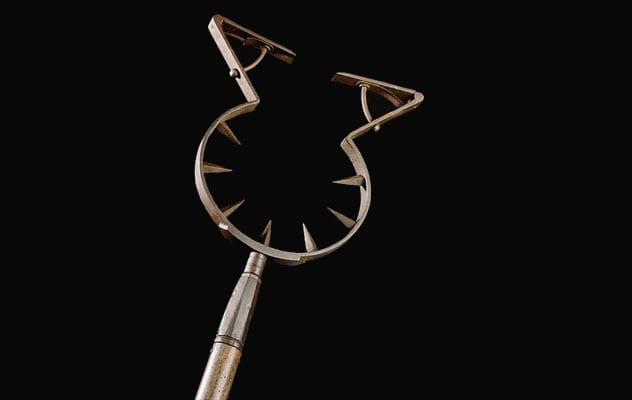
One of the strangest weapons in history was more commonly used in city streets rather than on the field of battle: the man catcher. Interestingly, it was one of the few medieval weapons that was designed specifically to incapacitate an opponent without killing or injuring him.
While some man catchers had spikes on them, which were clearly designed to cause injury, the vast majority were simply a wooden shaft with a two-pronged blunted fork at the end. They were used by the night watchmen and guards of medieval towns to pin down the limbs of troublemakers or criminals. This restrained them until help arrived or they calmed down.[1]
The man catcher was occasionally employed on the field of battle, though this was much less frequent. These man catchers were more elaborate, often featuring sharpened spikes and spring-loaded doors to trap victims’ limbs.
They were sometimes used to drag foes from their horses, but such a move would have taken considerable skill. They were more commonly used to seize wealthy nobles and take them prisoner. When the battle was over, they could be ransomed for a large amount of money.
There are no concrete sources on when man catchers were first employed, but they were used throughout the Middle Ages across the world—from Europe to Japan. They continued as a law enforcement tool well into the 1600s.
9 Bagh Nakh
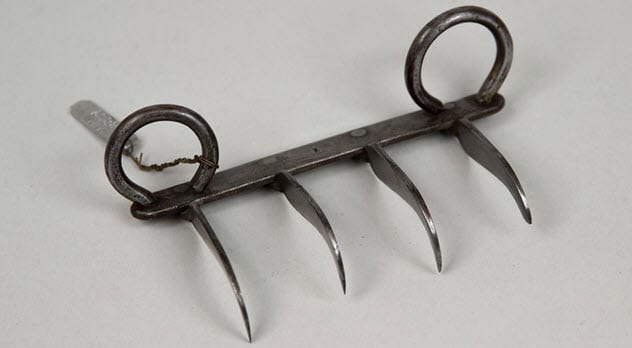
The bagh nakh (“tiger’s claw”) was an unusual weapon invented in India. Although no one knows for sure when it first appeared, it grew in popularity after being adopted by the Nihang Sikh warriors sometime after 1500.
In short, it was a form of knuckle duster, easily concealed in the palm and made up of four or five metal claws that were used to slash at the opponent. Nihang Sikhs often carried them in their turbans as concealed weapons but also fought with them in battle on occasion.
They were also employed as weapons of underhanded attack and even assassination. Famously, a bagh nakh was used in the meeting between General Afzhal Khan and Emperor Shivaji.
Both men had agreed to meet unarmed, but Shivaji brought armor and a bagh nakh with him just in case. When Khan attacked Shivaji unexpectedly, Shivaji killed Khan with a bagh nakh and saved his own life.[2]
8 Caltrop
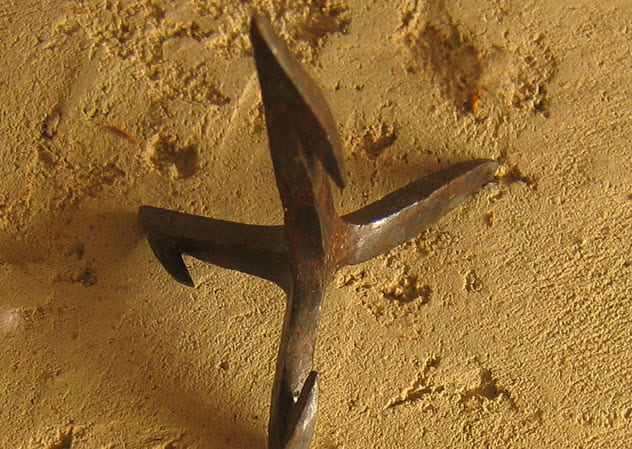
Despite being a relatively obscure weapon even today, the caltrop has been employed with considerable success for at least 2,000 years. In its basic form, a caltrop is a piece of iron fashioned into four equally long points.
It is assembled so that if it is dropped on the ground, a point faces straight up. This innovation made them relatively easy to quickly scatter over a wide area because no skill was required to lay them.
The first account of caltrop use comes from the Roman Empire when Roman writers discussed the use of murex ferreus (“jagged things of iron”) to disrupt the horse-drawn chariots used by various cultures across Europe at the time. They were used as early as the Battle of Carrhae in 53 BC, but accounts that may feature caltrops date as far back as Alexander’s campaigns in Persia around 331 BC.
It was employed across the world—from Japan, where the spikes were rarely longer than 2.5 centimeters (1 in), to India, where large, elaborate caltrops were used to halt the charges of war elephants.
Their use declined with the invention of gunpowder, but they were still employed on rare occasions. In fact, they are still deployed today. They were used as antipersonnel weapons in the Korean War to prevent ambushes and have been used into the 21st century to neutralize vehicles.[3]
7 Bill Hook
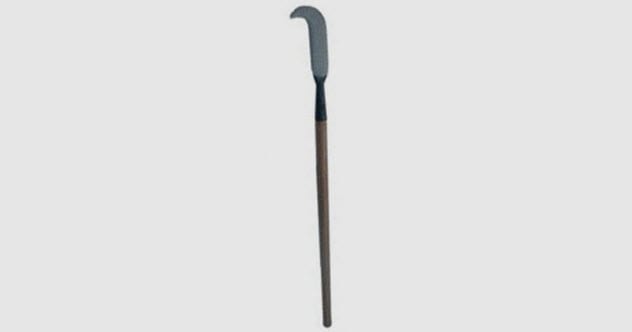
Evolving from the agricultural bill hook, the martial bill hook (sometimes called the “English bill” or just the “bill”) was a relatively common weapon in the late Middle Ages and the Renaissance. Its flexibility and simple construction made it the weapon of choice of many poor soldiers or drafted peasants.
Its design varied significantly across Europe, but it was consistently a multipurpose weapon. Its broad, curved head could be used to slash in a similar fashion to a glaive, while the small hook on the end could catch the edges of armor plate and drag opponents to the ground or off their mounts. Later, bill hooks also had a long spike on top that allowed them to be used as spears or pikes if needed.
They fell out of fashion across Europe in the 1500s, replaced by the pike and arquebus. Despite this, professional soldiers in England stuck with the old bill and bow combination as late as the Battle of Flodden, by which time the Scots had long abandoned the bill hook. Examples of English bills have even been found in Jamestown, suggesting that they were still in use as late as 1607.[4]
6 Lantern Shield
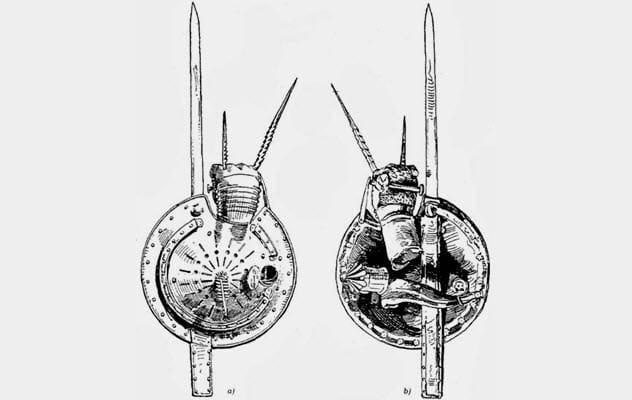
At the dawn of the Renaissance, Italy was the place to be. Whether you were interested in art, science, or engineering, the world’s best and brightest were gathered in the Italian states, where their work was supported by wealthy princes and merchants.
The best—and most outlandishly styled—armor was made in Italy, especially in Milan. Europe’s richest and most fashion-conscious all had their armor made by Italian smiths.
It should be no surprise then that one of the strangest and most elaborate shields in human history was designed in Renaissance Italy. At the time, there was a strong dueling culture among the country’s youth. Many young men would go out after dark to cause trouble on the streets or to take part in prearranged duels. Cue the invention of the lantern shield.
At first, lantern shields were simply shields that had a hook or other secure place to fasten a lantern so that those who dueled after dark could still see. The concept developed over time, however, and by the height of the Renaissance, the most advanced lantern shields had all kinds of features: serrated gauntlets designed to catch and break an opponent’s sword, spikes that jutted out of the shield’s front, and even sword blades that were forged into the shield, making it a weapon in itself.[5]
Their strangest feature, however, was a small flap covered by a piece of leather. The user mounted a lantern behind this flap. According to dueling practice books from the time, these lantern flaps could be used to blind an opponent in a pinch, temporarily putting them out of action.
5 Fletched Javelin
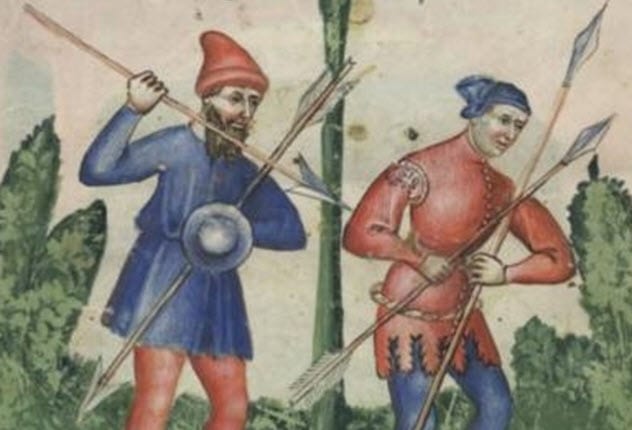
Most of us know that javelins were commonly used across the Greek and Roman worlds. However, many don’t know that javelins were used well into the medieval period and beyond.
In fact, medieval javelins were more advanced than their ancient counterparts and were a lot more accurate. These special medieval weapons, often called fletched javelins, had feather fletchings at the bottom of their shafts which steadied the javelin in flight.
They resembled giant arrows and appeared semi-regularly in medieval artwork. They were also built differently from regular javelins, with crafters using lighter, less durable wood but larger and heavier heads to cause more damage on impact. They found considerably more use in the early medieval period, which then declined as the popularity of the longbow and crossbow grew.
The fletched javelin was also used in other parts of the world. In the Americas, native cultures used a special kind of sling known as an atlatl. This wooden tool could be used to launch a fletched javelin with twice the strength of a regular throw just by flicking the wrist. A similar leather sling was used by the ancient Greeks to launch javelins, but that stopped well before the Middle Ages.[6]
There isn’t an exact term for these medieval javelins, though they are most commonly referred to as either fletched javelins or war darts. As they are thrown and have fletchings, they are technically darts. They probably wouldn’t be accepted by your local darts club, though.
4 Chakram
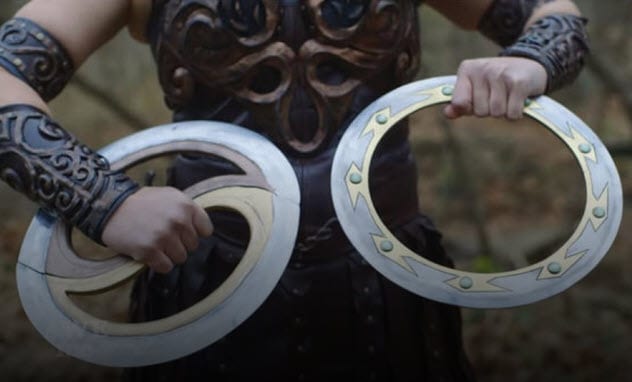
Throwing knives features prominently in our television and video games, but the Indian equivalent, a battle quoit, is even more bizarre. A sharpened metal disc, the chakram, or chakkar, is effectively a war frisbee.
It has been used by the nomadic Akali Nihang Sikhs for hundreds of years, though the oldest accounts of its use date back more than 2,000 years. They can vary significantly in size, from little wider than a hand to over 0.6 meters (2 ft) wide.
They can be thrown in many ways. The most common technique is to spin the disc on the finger and quickly release it, though underarm throws—which launch the disc vertically—are also well known. They can be thrown on the move and, for extra force, by using diagonal throws that build up a lot of speed.[7]
In battle, they were deployed en masse by soldiers in the back ranks, who launched them high into the air to fall on their enemies’ heads. These weapons were carried into battle on the warrior’s arm, allowing him to carry up to a dozen at a time. However, the largest ones were worn around the neck.
They were also useful in melee combat, cutting any enemy who tried to grapple them. If needed, they could even be used as close-quarters weapons.
3 Net
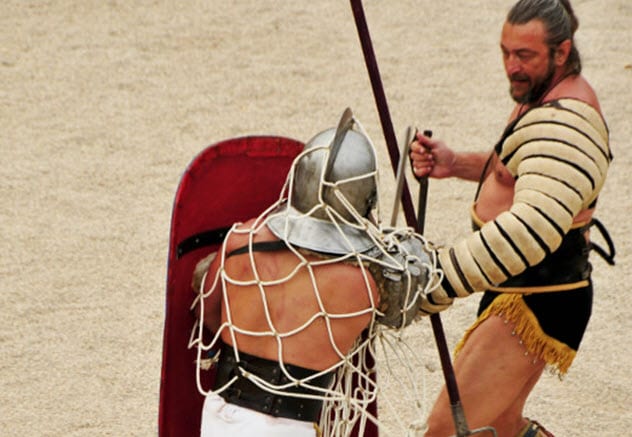
Nets have been used in warfare by many different cultures for millennia, but they reached the height of their popularity in the gladiatorial arenas of ancient Rome. The gladiator games began as reenactments of real battles, with most gladiators wearing the gear of either Romans or their common enemies. Over time, however, the gladiator games—and the gladiator classes—developed a culture of their own.
Most gladiators wore large, elaborate helmets featuring everything from animal crests to exaggerated trims. While these helmets were impressive, they could also put the fighter at a disadvantage, especially when pitted against a retiarius.
A retiarius was a gladiator who took to the field with a trident and a net. He used his net to catch his opponent’s helmet and drag him down. Retiarii were some of the most popular gladiators in ancient Rome and were frequently fan favorites.
As they required very little armor and their weapons were very cheap, they were also some of the most common. In fact, a gladiator class appeared solely to counter the effectiveness of the retiarii.[8]
This class, known as the secutor, wore a very basic helmet with no crest so that it couldn’t be caught by the retiarius’s net. The secutor‘s helmet also had small eye holes so that the trident couldn’t be thrust into his eyes.
By the end of the first century AD, this pairing was one of the most popular in the gladiatorial world. It remained so until the decline of the Roman Empire.
2 Khopesh
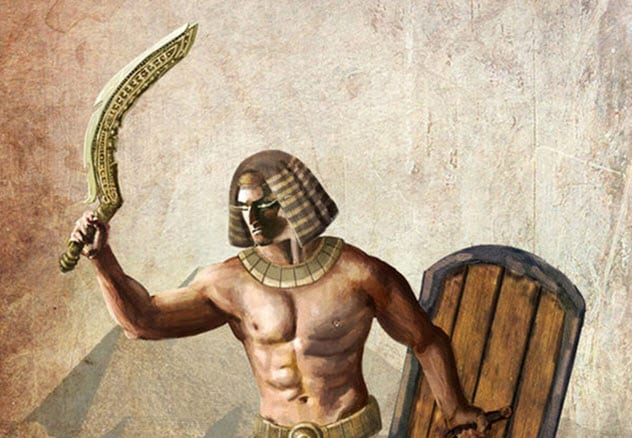
The khopesh is one of the oldest weapons of war in human history to be made entirely of metal. The first examples were forged in Mesopotamia around 2500 BC. The design quickly spread to Egypt, where it became the favored weapon of the warrior class—and, arguably, the world’s first sword.
Swords as we recognize them today became common in the 16th century BC, but before then, the khopesh dominated the Near East. Whether or not the khopesh is a sword, however, is still debated. It evolved from the sickle, a farm implement, and the axe, which people had started to use in warfare.
The result was a strange-looking, curved weapon with a sharp, axe-like edge and a hefty amount of metal behind it, making it just as good at bashing through armor as it was at slicing. Its sharpened tip meant that it could also be used as a stabbing weapon.[9]
The khopesh was one of the most advanced weapons of its age, but it was also incredibly expensive to make. Only professional warriors and nobility could afford to own one, so it quickly became a symbol of Egypt’s ruling elite.
As time went on, more and more khopeshes were made with blunted edges, seemingly designed to serve as decorations or as grave goods. By the time the age of pharaohs ended, these weapons were even frequently appearing in the tombs of the mighty rulers themselves.
1 Kpinga
Using a throwing knife requires a fair bit of skill. Of course, the user needs to be able to throw the weapon accurately, which takes practice on its own. But he also needs to judge the distance and work out how to throw the blade so that the sharp end hits the target.
Many cultures around the world have used various innovations to get around this. Like the aforementioned chakram, the Japanese shuriken is deadly no matter which part of the weapon hits the target, while the boomerang has a much larger surface area that can cause damage.
The Azande people of Africa solved this problem in a different way. They made a throwing knife, the kpinga, with multiple blades. The blades are oriented so that the unfortunate enemy will be hit by a sharpened edge no matter how the knife is thrown. They were most commonly thrown overhead, but they could also be thrown sidearm, a low throw which aimed to take out the target’s legs.
The kpinga was a weapon of prestige, a status symbol that was only given to people of wealth and repute—or to professional warriors. The right to produce them belonged to a single clan, the Avongara, and they were sometimes part of the dowry given at a wedding.[10]
They were so valued that when they were used, warriors were expected to shout that they were throwing their knife to prove they weren’t just discarding it wastefully.
Read about more badass ancient weapons on Top 10 Badass Ancient Weapons and 10 Badass Ancient Weapons From Around The World.








